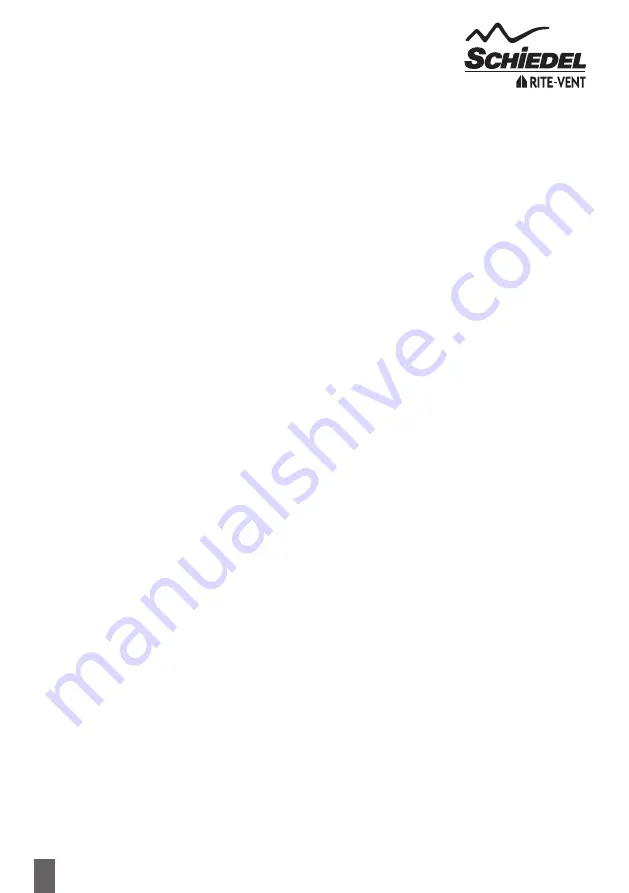
Appliance/Chimney Connection
Connection to the appliance can be made using Prima Smooth, Prima Plus or alternative approved single wall connecting
flue pipes, or ICID Plus.
This must be done by using the appropriate appliance connector. When a single wall connecting flue pipe is used to
connect an appliance to the chimney, the lower end of the chimney section must extend a minimum of 425mm below
the ceiling. When connecting the appliance to the flue pipe all joints between the flue pipe/appliance outlet must be
securely caulked and sealed with non asbestos rope (or suitable alternative) and fire cement on solid fuel appliances.
Any flue pipe connection to the chimney MUST be made in the same room as the appliance.
Provision for Condensate Disposal
(subject to appliance manufacturers’ recommendations)
Condensing appliances need provision for drainage. Choose the appropriate flue drainage components normally fitted
at the base of the vertical stack and/or close to the appliance outlet. Any ‘horizontal’ runs must allow for a minimum 3°
slope and therefore, where required, 87° bends and 93° tees must be used rather than 90° bends and tees.
Connection to Draught Diverter
Where the appliance features a draught diverter the connection should rise vertically from it for at least 600mm before
any change of direction (unless otherwise specified by the appliance manufacturer). This is in accordance with the
recommendations contained in BS 5440 Part 1 section 6.1.4
Connecting Flue Pipe Diameter
Connecting Flue Pipe Diameter size should be as recommended by the appliance manufacturer. Under all circumstances
the operational requirements of the appliance and the configuration of the flue must satisfy the flue sizing requirements
of EN13384-1.
Distance to Combustibles
In accordance with building regulations, it is essential that the correct distance to combustible material is maintained
on connecting flue pipes. On solid fuel applications, where there is a risk of soot fire, on unmeasured (NM) designated
single wall product, this distance is 3 x ØInt of the pipe, e.g. for Ø125mm the distance is 375mm and for Ø150mm the
distance is 450mm to combustibles on both painted and non painted variants. On measured (M) single wall or double wall
products this distance will be as declared by the chimney manufacturer. On ICID Plus this distance has been measured and
is set at 100mm.
Connecting Flue Pipe Route
Single wall connecting flue pipes should only be used to connect appliances to a Chimney. They should not pass through
any roof space, partition, internal wall or floor, except to pass directly into a chimney through a wall of the chimney.
Connecting flue pipes should be located as to avoid igniting combustible material.
On solid fuel appliances the maximum length of a connecting flue pipe is 2m. This distance is reduced to 1.5m if any of
the acceptable alternative methods of connection are adopted as per BS EN15287-1. (See p.5-6 for full details.)
On appliances with a top outlet, it is recommended that a vertical run of at least 600mm should be allowed immediately
above the appliance prior to any change of direction.
On appliances with a rear outlet, it is recommended that there is maximum of 150mm in the horizontal run however
under certain conditions, as described in alternative methods in BS EN 15287-1, this may be increased to 450mm. (See
p.5-6 for full details.)
Within a system (C Connecting Flue Pipe) there should be no more than 4 changes of direction of maximum 45˚.
90˚ Factory made bends or tees within the system may be treated as being equal to two 45˚ bends (as per Document
J of the Building Regulations issued October 2010).
Inspection
On solid fuel applications to conform to Building Regulations, provisions should be made to enable a chimney to be
inspected and cleaned.
An inspection pipe, inspection elbow or a 90° or 135° Tee with tee cap can form a suitable inspection point (unless
cleaning/inspection can be done through the appliance). To aid cleaning, sufficient distance should be left between changes
of direction to permit the safe passage of cleaning brushes within the system. This is particularly important on solid fuel
applications. It is recommended that chimneys serving solid fuel appliances be swept as frequently as necessary, but at
least twice a year.
4
CONNECTING FLUE PIPE





































